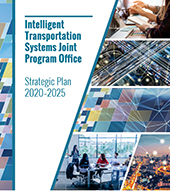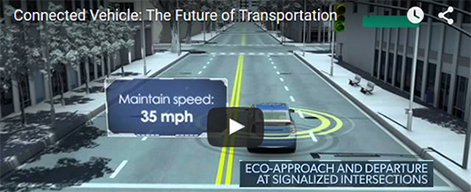About ITS JPO
JPO Program Status Reports Feb 08
|
STATUS INDICATOR DEFINITIONS |
|||
|
G |
Y |
R |
|
COST |
Program Within Budget |
Program Costs >1% but < 10% Over Budget |
Program Costs > 10% Over Budget |
|
SCHEDULE |
Goal Achievement On Time |
Goal Achievement 1 to 4 Weeks Late |
Goal Achievement > 1 Month Behind Schedule |
|
PERFORMANCE |
Goals/Major Objectives Will Be Achieved |
Goals/Several Major Objectives In Jeopardy |
Goals Will Not Be Achieved |
|
Program Title: CICAS JPO Program Manager: Schagrin |
Current Updates (as of 2/8/08): |
|||
Program is currently underway with prime objectives being accomplished. |
||||
Program Description Summary |
||||
The CICAS Initiative is designed to employ a combination of vehicle-based technologies and systems, infrastructure-based technologies and systems, and communications systems focused on detecting and avoiding potential crossing-path crashes at intersections. CICAS will combine these technologies, thereby creating three innovative applications: an application that warns drivers of potential signal or stop sign violations, an application that assists the driver’s decision making capability when proceeding onto a high speed road after making a legal stop at a stop sign, and an application that assist the driver’s decision making capability when turning left in the face of oncoming traffic. The major focus of this initiative is to determine if these systems are effective at reducing crossing path crashes while achieving a sufficient level of driver acceptance. |
||||
Program Goals |
||||
|
||||
Program Status (as of2/8/08) |
||||
Cost |
Schedule |
|||
G |
G |
|||
Original Budget: |
$ 43,477,450 |
Current PoP (Months): |
(48 months)
|
|
Current Budget |
$ 39,494,640 |
Original PoP: |
5/06-9/10 |
|
FY 08 Budget |
$ 4,600,000 |
|
|
|
Obligated: |
$ 19,797,418 |
Mod: |
Mod to extend Phase 1 CICAS-V by 3 months. |
|
Expended to Date: |
$ 9,938,981 |
Mod: |
SSA and SLTA being descoped to no longer include an FOT |
|
Amount Remaining: |
$ 9,858,437 |
|
|
|
|
Performance G (as of 2/8/08) |
||||
Major Objectives/Deliverables |
Original Schedule |
Actual |
Revised |
|
Signal and stop sign violation:
|
Aug 2008
Sept 2010 |
|
|
|
Signalized left turn assist:
|
Sept 2008
Aug 2009 |
|
|
|
|
|
|
|
|
Management Summary |
||||
|
% Program Schedule Elapsed: |
24 % (as of Dec 07 ) |
|||
% Program Budget Expended: |
25 % (as of Dec 07) |
|||
Issues |
||||
|
||||
Program Title: Clarus |
Current Updates (as of 1/31/08): |
|||
|
||||
Program Description Summary |
||||
The Clarus Initiative will develop and demonstrate a high resolution, integrated surface transportation weather observing, forecasting, and data management system; and will establish partnerships to create timely, accurate, and relevant weather and road condition information for transportation users and operators. |
||||
Program Goals |
||||
|
||||
Program Status (as of1/31/08) |
||||
Cost |
Schedule |
|||
G |
G |
|||
Original Program Budget: |
$11.5 million |
Current PoP (Months): |
( 72 months) 10/01/05 – 9/30/10 |
|
Current Program Budget: |
$15.9 million |
Original PoP: |
10/01/04 – 9/30/09 |
|
FY 08 Budget: |
$4.8 million |
|
|
|
Obligated: |
$7.7million |
Mod 1: |
9/30/10 |
|
Expended to Date: |
$7.7 million |
|
|
|
Amount Remaining: |
$8.2 million |
|
|
|
|
Performance G (as of 1/31/08) |
||||
Major Objectives/Deliverables |
Original Schedule |
Actual |
Date Revised |
|
Establish Stakeholder Participation |
September 2004 |
September 2004 |
|
|
System Design |
December 2006 |
December 2006 |
|
|
System Proof of Concept |
December 2006 |
December 2006 |
|
|
Regional Demonstration Con Op |
January 2008 |
On Schedule |
|
|
Complete Phase 3 Regional Demonstration |
September 2009 (revised to Sept. 2010) |
On Schedule |
May 2007 |
|
Thirty-three states connected to Clarus |
September 2010 |
On Schedule |
|
|
Transition system operations to NOAA |
September 2010 |
On Schedule |
|
|
Management Summary |
||||
|
% Program Schedule Elapsed: |
43% (as of 1/31/08) |
|||
% Program Budget Expended: |
48% (as of 1/31/08) |
|||
Issues |
||||
|
||||
Program Title: Congestion Initiative, ITS-OTMC JPO Program Manager - Brian Cronin (Overall Coordination, SF, NY, Miami and Evaluation) |
Current Updates (as of 02/01/08): |
|||||||
Currently working to obligate ITS funds. Except for San Diego, obligations are conditional on sites receiving legal authority to price. Evaluation contractor recommendation provided to contracts on 01/25/08. |
||||||||
Program Description Summary |
||||||||
In May 2006, the U.S. Department of Transportation (USDOT) announced its National Strategy to Reduce Congestion on America’s Transportation Network (the Congestion Initiative), a bold and comprehensive national program to reduce congestion on the Nation’s roads, rails, runways and waterways. The Intelligent Transportation Systems (ITS) Operational Testing to Mitigate Congestion (ITS-OTMC) Program provides the advanced technology foundation for the Congestion Initiative. ITS technologies will support congestion pricing, improved system operations and performance, regional efforts to expand provision of real-time traveler information, improved traffic incident response, improved arterial signal timing and reduced obtrusiveness of highway construction work zones. The overall objective of the ITS-OTMC Program is to facilitate the operational testing and evaluation of innovative and aggressive congestion reduction strategies incorporating ITS technologies that can demonstrate measurable reductions in congestion levels in the deployment areas. |
||||||||
Program Goals |
||||||||
|
||||||||
Program Status (as of01/01/08) |
||||||||
Cost |
Schedule |
|||||||
G |
G |
|||||||
Original Program Budget: |
$ 100,000,000 |
Current PoP (Months): |
12/8/06 – 6/30/11 |
|||||
Current Program Budget |
$100,000,000 |
Original PoP: |
2/28/05 – 8/1/11 |
|||||
FY 08 Budget |
$40,000,000 |
|
|
|||||
Obligated: |
$8,600,000 |
|
|
|||||
Expended to Date: |
$ 0 |
|
|
|||||
Amount Remaining: |
$100,000,000 |
|
|
|||||
|
|
|
|
|||||
|
|
|
|
|||||
|
|
|
|
|||||
|
Performance G (as of 02/01/08) |
||||||||
Major Objectives/Deliverables |
Original Schedule |
Actual |
Revised |
|||||
Select Urban Partners |
8/8/07 |
8/8/07 |
|
|||||
Obtain Legislative Authority |
3/31/08 – 5/30/08 |
|
||||||
Select Evaluation Contractor |
3/31/08 |
|
|
|||||
Complete Evaluation Plans for Urban Partners |
9/30/08 |
|
|
|||||
Systems Operational |
9/30/09 |
|
|
|||||
Complete Evaluation Report |
5/30/11 |
|
|
|||||
|
|
|
|
|||||
|
|
|
|
|||||
Management Summary |
||||||||
|
% Program Schedule Elapsed: |
20% (as of 02/01/08) |
|||||||
% Program Budget Expended: |
0% (as of 01/01/08) |
|||||||
Issues |
||||||||
|
||||||||
Program Title: Electronic Freight Management Evaluation JPO Program Manager: Kate Hartman
|
Current Updates (as of 02/11/08): |
|||||||
SAIC continued to fully implement its evaluation data collection and analysis activities. This included significant follow-up interviews and data requests from the project partners, including the Hong Kong participants. SAIC provided an Interim Evaluation Update at the Intermodal Freight Technology Working Group Meeting in Atlanta, Georgia. SAIC has been having regular telecons to discuss progress. |
||||||||
Program Description Summary |
||||||||
The Electronic Freight Manifest (EFM) initiative combines the successful elements of the air cargo tests and the IFTWG’s Freight Information Highway Test and is designed to enhance freight transportation productivity through the intelligent application of technology enhancements. The EFM deployment project is composed of three distinct phases - Design and Development, Deployment, and Operations. The evaluation effort is expected to mirror these phases. During the Design and Development Phase of the underlying EFM deployment, the evaluation contractor similarly designed and developed the evaluation framework. It included the design of the overall evaluation strategy, analysis of preliminary data, and |
||||||||
Program Goals |
||||||||
The deployment of the EFM will result in:
|
||||||||
Program Status (as of09/07/07) |
||||||||
|
Cost |
Schedule |
|||||||
G |
G |
|||||||
Original Budget: |
$999,815 |
Current PoP (Months): |
(45 months) 4/1/05 – 12/31/08 |
|||||
Current Budget |
$999,815 |
Original PoP: |
4/1/05 – 12/31/07 |
|||||
FY 08 Budget |
$0 |
|
|
|||||
Obligated: |
$999,815 |
Mod 1: |
Thru 12/31/08 |
|||||
Expended to Date: |
$540,656 |
|
|
|||||
Amount Remaining: |
$459,159 |
|
|
|||||
Performance G (as of 09/07/07) |
||||||||
Major Objectives/Deliverables |
Original Schedule |
Actual |
Revised |
|||||
Project Kick Off |
5/11/05 |
6/27/05 |
|
|||||
Evaluation Strategy Briefing |
7/13/05 |
9/13/05 |
|
|||||
Evaluation Plan |
8/30/05 |
1/19/06 |
|
|||||
Detailed Test Plans (Draft) |
11/10/05 |
6/12/07 |
|
|||||
Detailed Test Plans (Final) |
12/22/05 |
10/5/07* |
|
|||||
Draft CEFM Final Report |
3/08 |
|
|
|||||
Evaluation Final Results Briefing |
3/08 |
|
|
|||||
Draft JPO Lessons Learned Report |
4/08 |
|
|
|||||
Final CEFM Final Evaluation Report |
5/08 |
|
|
|||||
Final JPO Lessons Learned Report |
6/08 |
|
|
|||||
Draft CEFM Deployment Eval Report |
9/08 |
|
|
|||||
Final CEFM Deployment Eval Report |
11/08 |
|
|
|||||
Management Summary |
||||||||
|
% Program Schedule Elapsed: |
74% (as of 12/31/08) |
|||||||
% Program Budget Expended: |
54% (as of 12/31/08) |
|||||||
Issues |
||||||||
|
||||||||
Program: Emergency Transportation Operations (ETO) JPO Program Manager: Linda Dodge |
Current Updates (as of 02/08/08): |
|||||||
In the process of packing ETO documents completed to date into a CD with products developed as part of the Public Safety Program. Currently assessing a subset of tools selected from the modeling inventory. This assessment will be more detailed than the inventory and will categorize modeling approaches along a continuum of geographic scale as well as computational complexity. |
||||||||
Program Description Summary |
||||||||
The ETO was launched in 2004 with the goal of improving the speed and effectiveness of response to major incidents and management of those incidents. |
||||||||
Program Goals |
||||||||
To accomplish this ETO concentrated on providing the tools, procedures, and information that can be used to actively manage and therefore expedite the safe progress of an evacuation. |
||||||||
Program Status (as of02/08/08 ) |
||||||||
Cost |
Schedule |
|||||||
G |
G |
|||||||
Original Program Budget: |
$5,900,000 |
Current PoP (Months): |
n/a |
|||||
Current Program Budget |
$353,102.85 follow on
|
Original PoP: |
varied project (aprx. 14 proj. in original Initiative |
|||||
FY 08 Budget |
$0 new money |
|
|
|||||
Obligated: |
$353,000 $102.85 uncommitted |
|
|
|||||
Expended to Date: |
$5,500,000 |
|
|
|||||
Amount Remaining: |
$102.85 |
|
|
|||||
|
Performance Y (as of 02/08/08) |
||||||||
Major Objectives/Deliverables |
Original Schedule |
Actual |
Revised |
|||||
Camera Phone Proof of Concept Project Final Report (Orig. initiative) |
Fall 2006 |
July 30, 2007 |
|
|||||
Follow on: |
||||||||
Evacuation Management Operations (EMO) Modeling Assessment: |
28 May 2007 |
13 December 2007 |
|
|||||
Evacuation Model Users Guide |
1 August 2008 |
1 August 2008 |
|
|||||
Best of Public Safety / ETO CD |
1 May 2008 |
1 May 2008 |
|
|||||
|
|
|
|
|||||
|
|
|
|
|||||
|
|
|
|
|||||
|
|
|
|
|||||
|
|
|
|
|||||
Management Summary |
||||||||
|
% Program Schedule Elapsed: |
100% (as of 02/08/08); 75% of follow-on |
|||||||
% Program Budget Expended: |
100% (as of 02/08/087) [$102.85 remains of follow-on] |
|||||||
Issues |
||||||||
Original Initiative issues:
NOTE: all delays have been resolved to date. |
||||||||
Program Title: Integrated Corridor Management (ICM) JPO Program Manager - Brian Cronin |
Current Updates (as of 02/01/08): |
|||||||
On January 31, 6 of 8 ICM Pioneer Sites delivered their Draft Requirements Documents. The deliverable will be the final Pioneer Site deliverable for Stage 1. An ICM analysis, modeling, and simulation test corridor report will be completed in February. |
||||||||
Program Description Summary |
||||||||
The ICM Initiative will demonstrate how operational approaches and multimodal ITS solutions can be applied to proactively manage the movement of people and goods through major metropolitan transportation corridors. The Initiative will facilitate deployment of integrated corridor management systems by providing guidance on shifting travel demand to available capacity by delivering real-time travel data through in-vehicle devices, changeable message signs, and 511 services. |
||||||||
Program Goals |
||||||||
|
||||||||
Program Status (as of01/01/08) |
||||||||
Cost |
Schedule |
|||||||
G |
Y |
|||||||
Original Program Budget: |
$41,625,000 |
Current PoP (Months): |
2/28/05 – 12/30/11 |
|||||
Current Program Budget |
$37,410,645 |
Original PoP: |
2/28/05 – 10/27/11 |
|||||
FY 08 Budget |
$ 3,950,000 |
|
|
|||||
Obligated: |
$ 400,000 |
|
|
|||||
Expended to Date: |
$ 9,859,961 |
|
|
|||||
Amount Remaining: |
$27,550,684 |
|
|
|||||
|
Performance G (as of 02/01/08) |
||||||||
Major Objectives/Deliverables |
Original Schedule |
Actual |
Revised |
|||||
ICM Foundation Analysis |
3/31/2006 |
4/18/2006 |
4/18/2006 |
|||||
ICM Pioneer Site Con Ops |
3/27/2007 |
6/22/2007 |
6/22/2007 |
|||||
ICM Pioneer Site Requirements |
9/26/2007 |
|
3/31/2008 |
|||||
ICM AMS Site Feasibility Report |
8/31/2007 |
|
3/31/08 |
|||||
ICM Pioneer Site AMS Complete |
11/14/2008 |
|
9/1/2009 |
|||||
ICM Demonstration Award |
9/29/2008 |
|
8/1/2009 |
|||||
ICM Demonstration Complete |
10/27/2011 |
|
12/30/11 |
|||||
ICM Knowledge and Tech Transfer Final |
7/13/2011 |
|
12/30/11 |
|||||
Management Summary |
||||||||
|
% Program Schedule Elapsed: |
43% (as of 02/01/08) |
|||||||
% Program Budget Expended: |
26% (as of 01/01/08) |
|||||||
Issues |
||||||||
|
||||||||
Program Title: Integrated Vehicle-Based Safety Systems (IVBSS) JPO Program Manager: Steve Sill |
Current Updates (as of 02/01/08): |
|||
This report reflects verbal direction given by the RITA administrator at the December 21, 2007 Phase II Go-No/Go milestone decision meeting. The direction was to extend Phase I to demonstrate that the prototype light vehicle and heavy truck IVBSS fully meet project performance requirements. $361K in additional funding for the Phase I extension to be provided using JPO contingency funds. |
||||
Program Description Summary |
||||
The purpose of this program is to develop and field test an integrated, vehicle-based safety system addressing rear-end, lane change and road departure crashes for light vehicles and heavy commercial trucks. |
||||
Program Goals |
||||
|
||||
Program Status (as of 02/01/08) |
||||
Federal Costs* |
Schedule (as of 02/01/08) |
|||
G |
R |
|||
Original Program Budget: |
$35,428,000 |
Current PoP (Months): |
11/23/05 – 04/30/10 (53 months) |
|
Current Program Budget: |
$35,769,990 |
Original PoP: |
11/23/05 – 11/30/09 (48 months) |
|
Obligated: |
$32,428,000 |
|
||
Expended to Date: |
$21,282,702 |
|
|
|
Amount Remaining: |
$11,145,298 |
|
|
|
*Reflects most recent costs reported by contractors/grantees, delayed up to 60 days. |
|
|
||
|
Performance G (as of 02/01/08) |
||||
Major Objectives/Deliverables |
Original Schedule |
Actual |
Revised |
|
Human Factors and DVI Summary Report |
11/30/07 |
12/03/07 |
|
|
Preliminary FOT Report delivered* |
11/30/07 |
|
04/15/08 |
|
Phase I Interim Report delivered* |
01/15/08 |
|
04/15/08 |
|
Light Vehicle Verification Testing completed - Phase I extension (*new) |
03/01/08 |
|
|
|
Heavy Truck Verification Testing completed – Phase I extension (*new) |
03/15/08 |
|
|
|
* due dates reflect adjustment due to Phase I (4-month) extension (December 31, 2007 to April 30, 2008) |
||||
Management Summary |
||||
|
% Program Schedule Elapsed: |
49% |
|||
% Program Budget Expended: |
59% ( Reflects most recent costs reported by contractors/grantees, delayed up to 60 days.) |
|||
Issues |
||||
|
||||
Program Title: Mobility Services for All Americans (MSAA) JPO Program Manager: Yehuda Gross
|
Current Updates (as of 02/01/08): |
|||||||
On January 23-24, 2008, the USDOT hosted the demonstration phase 1 mid-term workshop in Alexandria VA. The eight phase 1 sites presented their system concept of operations and shared useful lessons learned with each other. The USDOT took the opportunity to clarify requirements and expectations with respect to the project and provide an outlook for the phase 2 of the demonstration. |
||||||||
Program Description Summary |
||||||||
To address growing concerns over rising costs and to improve service, the Mobility Services for All Americans (MSAA) initiative aims to bring all communities together in a coordinated effort to apply technological solutions to the barriers of accessibility and mobility for the transportation disadvantaged. Proper use of ITS applications can improve delivery of human service transportation by boosting service productivity, facilitating service coordination, and enhancing system accessibility. |
||||||||
Program Goals |
||||||||
|
||||||||
Program Status (as of02/01/08) |
||||||||
Cost |
Schedule |
|||||||
G |
G |
|||||||
Original Program Budget: |
$9,000,000 |
Current PoP (Months): |
(69 months) 10/01/04 – 06/30/10 |
|||||
Current Program Budget |
$9,000,000 |
Original PoP: |
10/01/04 – 03/31/09 |
|||||
FY 08 Budget |
$3,500,000 |
|
|
|||||
Obligated: |
$4,334,828 |
Mod 1: |
- 06/30/10 |
|||||
Expended to Date: |
$1,954,675 |
|
|
|||||
Amount Remaining: |
$2,380,153 |
|
|
|||||
|
Performance G (as of 02/01/08) |
||||||||
Major Objectives/Deliverables |
Original Schedule |
Actual |
Revised |
|||||
TMCC Concepts of Operations (8) |
11/30/06 |
10/31/07 |
|
|||||
TMCC System Designs (8) |
09/30/07 |
|
06/30/08 |
|||||
MSAA Stakeholder Outreach Plan |
09/30/08 |
|
|
|||||
TMCC Institutional Evaluation Report |
|
|
03/31/09 |
|||||
TMCC System Deployments (2) |
12/31/08 |
|
12/31/09 |
|||||
TMCC System Impacts Evaluation |
|
|
06/30/10 |
|||||
Management Summary |
||||||||
|
% Program Schedule Elapsed: |
58% (as of 02/01/08) |
|||||||
% Program Budget Expended: |
% (as of 02/01/08) |
|||||||
Issues |
||||||||
|
||||||||
Program Title: Next Generation 9-1-1 (NG9-1-1) JPO Program Manager: Linda Dodge |
Current Updates (as of 02/08/08): |
|||||||
From a set of more than 50 applicants, DOT selected five 9-1-1 call centers or authorities to participate in this Spring’s NG9-1-1 proof-of-concept demonstration. |
||||||||
Program Description Summary |
||||||||
To enable the general public to make a 9-1-1 “call” (any real-time communication – voice, text, or video) from any wired, wireless, or Internet Protocol (IP)-based device, to the PSAP, and enable data sharing with the emergency communication network. |
||||||||
Program Goals |
||||||||
|
||||||||
Program Status (as of02/08/08 ) |
||||||||
Cost |
Schedule |
|||||||
G |
G |
|||||||
Original Program Budget: |
$6,056,614 |
Current PoP (Months): |
24 |
|||||
Current Program Budget |
$5,381,614 |
Original PoP: |
24 |
|||||
FY 08 Budget |
$675,000 |
|
|
|||||
Obligated: |
$454,000 |
|
|
|||||
Expended to Date: |
$ 3,153,873 |
|
|
|||||
Amount Remaining: |
$1,945,127 |
|
|
|||||
|
Performance Y (as of 02/08/08) |
||||||||
Major Objectives/Deliverables |
Original Schedule |
Actual |
Revised |
|||||
Draft System Design Document |
17-Sep-07 |
15-Nov-07 |
8-Nov-07 |
|||||
Critical Design Review (PDR) Meeting |
17-Sep-07 |
15-Nov-07 |
15-Nov-07 |
|||||
Interim System Design Documents |
29-Oct-07 |
Under Revision |
18-Jan-08 |
|||||
Final Proof-of-Concept Deployment Plan |
12-Nov-07 |
Under Revision |
18-Jan-08 |
|||||
Final Summary Report of Call Taker HMI and Human Factors Issues |
1-Oct-07 |
28-Nov-07 |
6-Nov-07 |
|||||
Final HMI Design Document |
12-Nov-07 |
16-Jan-08 |
18-Jan-08 |
|||||
Benefit-Cost Analysis Report |
18-Jun-07 |
11-Jan-08 |
18-Jun-07 |
|||||
Transition Issues Report |
2-Jul-07 |
5-Feb-08 |
25-Jan-08 |
|||||
Preliminary Transition Plan |
21-Jul-08 |
|
21-Jul-08 |
|||||
Management Summary |
||||||||
|
% Program Schedule Elapsed: |
54% (as of 02/08/08) |
|||||||
% Program Budget Expended: |
52% (as of 02/08/087) |
|||||||
Issues |
||||||||
|
||||||||
Program Title: VII JPO Program Manager: Schagrin |
Current Updates (as of 02/8/8): |
|||||||
|
||||||||
Program Description Summary |
||||||||
The VII Initiative is a cooperative effort between USDOT, State governments, and the automobile industry. The initiative will develop and test an information infrastructure that uses advanced communications technologies to exchange real-time information between the roadside and vehicles and between vehicles to improve safety and mobility. Applications are being developed to test multiple safety and mobility uses of VII. VII seeks to achieve significant reductions in vehicle crashes through safety applications and vehicle delay through State and local management of the surface transportation network enhanced by real-time traffic information and improved transportation systems operation. VII seeks to determine the technical feasibility, economic viability, and social acceptability of a coordinated, nationwide communications system deployed on the road infrastructure, and installed in all vehicles sold in the US. |
||||||||
Program Goals |
||||||||
|
||||||||
Program Status (as of02/08/08) |
||||||||
Cost |
Schedule |
|||||||
Y |
G |
|||||||
Original Budget: |
$ 91,273,359 |
Current PoP (Months): |
(xx months)
|
|||||
Current Budget |
$ 93,331,859 |
Original PoP: |
8/05-12/10 |
|||||
FY 08 Budget |
$ 22,000,000 |
|
|
|||||
Obligated: |
$ 88,076,811 |
Mod 1: |
||||||
Expended to Date: |
$ 67,002,861 |
|
|
|||||
Amount Remaining: |
$ 21,073,950 |
|
|
|||||
|
Performance Y (as of 02/08/08) |
||||||||
Major Objectives/Deliverables |
Original Schedule |
Actual |
Revised |
|||||
Currently rescoping and rebaselining the VII program. |
Dec 2007 |
|
March 2008 |
|||||
Establishing Volpe Tiger Team for developing and executing initial deployment capability |
Jan 2008 |
Jan 2008 |
|
|||||
Begin proof of concept testing of infrastructure, vehicles and applications in Detroit and California. |
Jan 2008 |
February 2008 |
|
|||||
Proof of Concept testing complete. |
March 2008 |
|
May 2008 |
|||||
Preliminary analyses of business model and institutional issues. |
May 2008 |
|
|
|||||
Initial deployment operational |
Dec 2008 |
|
|
|||||
Management Summary |
||||||||
|
% Program Schedule Elapsed: |
% (as of ) |
|||||||
% Program Budget Expended: |
% (as of ) |
|||||||
Issues |
||||||||
|
||||||||
Program Title: VSCA (V2V) JPO Program Manager: Schagrin |
Current Updates (as of 2/8/08): |
||||||
Project remains on schedule and within budget. |
|||||||
Program Description Summary |
|||||||
The VSCA program is a collaborative effort between the US DOT and a consortium of five automobile manufacturers (DaimlerChrysler, Ford, General Motors, Honda, and Toyota) to explore the use of vehicle-to-vehicle (V2V) wireless communication to improve the effectiveness of vehicle collision avoidance systems. |
|||||||
Program Goals |
|||||||
|
|||||||
Program Status (as of09/07/07) |
|||||||
Cost |
Schedule |
||||||
G |
G |
||||||
$11,106,000 |
Current PoP (Months): |
(36 months)
|
|||||
Current Budget |
|
Original PoP: |
12/06-11/09 |
||||
FY 08 Budget |
$ 4,897,000 |
|
|
||||
Obligated: |
$ 3,750,000 (plus Volpe) |
Mod 1: |
|||||
Expended to Date: |
$ 1,245,069 |
|
|
||||
Amount Remaining: |
$ 2,804,931 |
|
|
||||
|
Performance G (as of 09/07/07) |
|||||||
Major Objectives/Deliverables |
Original Schedule |
Actual |
Revised |
||||
|
June 2007 |
June 2007 |
|
||||
|
March 2007 |
March 2007 |
|
||||
|
June 2008 |
|
|
||||
|
April 2009 |
|
|
||||
|
December 2009 |
|
|
||||
Management Summary |
|
|
% Program Schedule Elapsed: |
27 % (as of Sept 07) |
% Program Budget Expended: |
11 % (as of Sept 07 ) |
Issues |
|
|
|
This program summary includes:
- CAMP (prime)
- Volpe (Independent evaluator)










